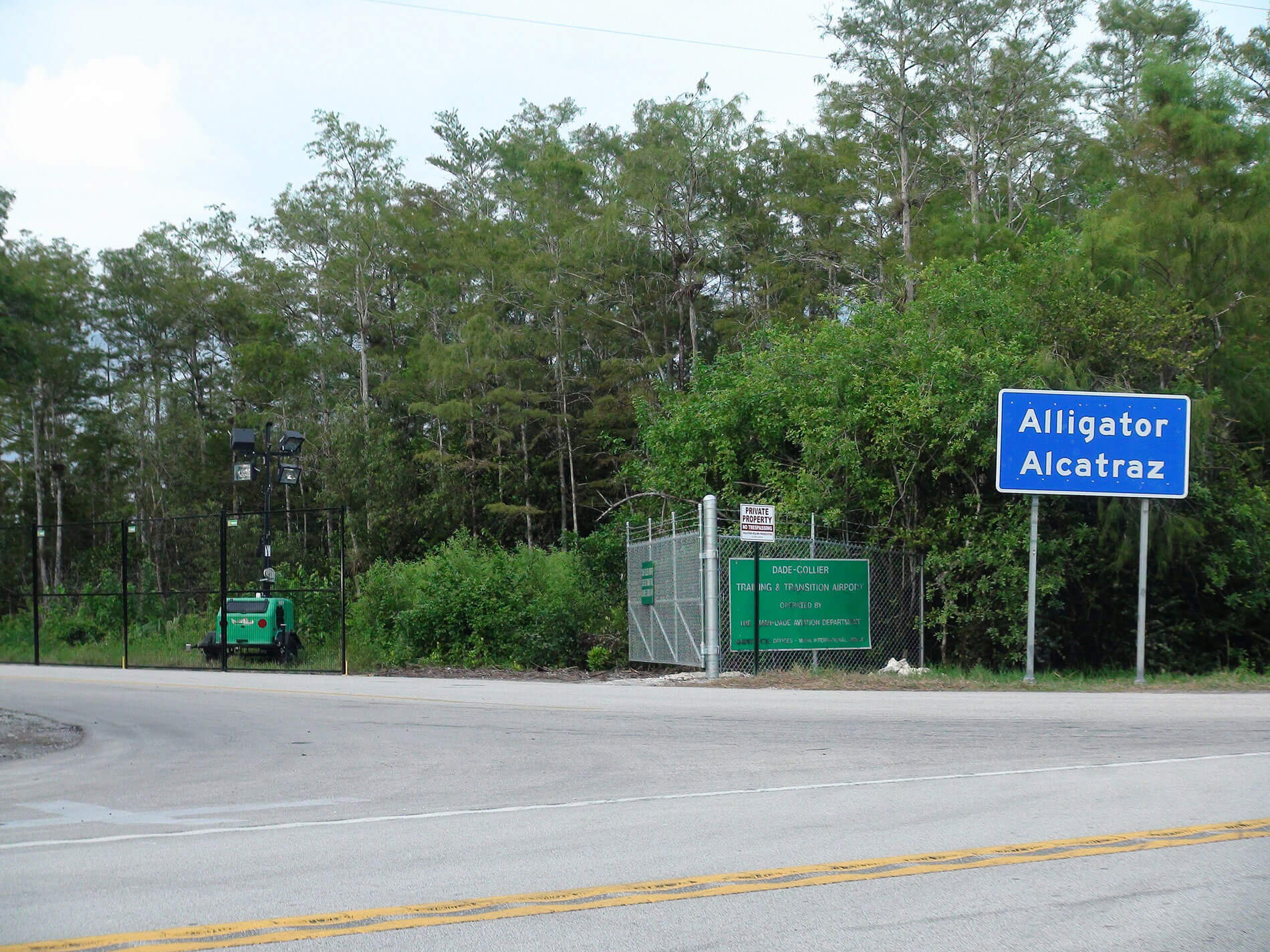“Efficient.” This word is used repeatedly in Homeland Security secretary Kristi Noem’s descriptions of Alligator Alcatraz, Florida’s new immigration detention center located at the former Dade-Collier Training and Transition Airport. The facility was built in the Everglades over the span of a week after Florida Governor Ron DeSantis leveraged a 2023 emergency order to expedite its construction. As Noem explained, the ICE detention center’s hasty, low-cost construction allows contractors to “expand facilities and bed space in just days.” With millions of people set to be deported, Florida Attorney General James Uthmeier celebrated the “efficient” and “low-cost opportunity to build a temporary detention facility.”
The company in charge of constructing Alligator Alcatraz is SLSCO, LTD., which has been promised $19.7 million for its services so far. The company, whose website lists its major services as construction, disaster response, federal services, and health & humanitarian operations, has been connected to a variety of scandals, including cheating New York City and New York State out of funds meant for COVID relief. It also allegedly stiffed North Carolina out of millions-of-dollars in Hurricane Helene relief funds and was accused of secretly hiring armed mercenaries from Mexico to guard the border wall that it was hired to build. SLSCO, LTD. did not respond to a request to comment for this story.
Alligator Alcatraz has been described by some as an internment camp, and others a concentration camp. It can be understood as a small carceral city, with its own “efficient” forms of traffic, parking, plumbing, housing, and even self-governance—the campus has a building labeled “Town Hall,” and even an airport. Already, architecture scholars have studied how military operations are seeping into urban contexts, and there are real precedents like Cop City in Atlanta or the Chicago Police Department’s training facility.
While a judge has now ordered Alligator Alcatraz to be shut down, it will only proliferate: The structure is a prototype that is being replicated across the country. Architects and others who oppose the alleged human rights violations occurring in these self-contained prison towns ought to pay close attention to the “aesthetics of emergency” that is being proliferated in the name of “efficiency.”
The Aesthetics of Emergency
The philosopher Walter Benjamin, on the run from Nazis, observed: “The tradition of the oppressed teaches us that the ‘state of emergency’ in which we live is not the exception but the rule.” We are accustomed to seeing this aesthetic every day in schools that are designed like prisons in the hopes of evading yet another mass shooting, pop-up tents to distribute tests and shots during the COVID pandemic, and the spectacle of post-9/11 airport security infrastructure. We must look deeper into why the new wave of campuses like Alligator Alcatraz, built by companies that have far more experience in disaster management than detention, fit so neatly into this aesthetic of emergency.
From a birds-eye view, Alligator Alcatraz looks neat and tidy: Its complex of gleaming white warehouse-type structures with A-frame roofs float over an asphalt pad, with adjoining orderly rows of small trailers in a matching white hue. But zoom in closer, and you’ll find that the walls of those warehouses are wrinkled. They are, in fact, nothing more than tents, ready to store 3,000 human beings. In recent photo-ops showing Noem and President Trump touring these metal cages, it’s not easy to see that the walls are made of fabric, making it hard to control the climate. According to reports from those that have spent time inside Alligator Alcatraz, inadequate and faulty air conditioning has left prisoners trapped in sweltering Florida heat.
This is one of many examples of how the much-touted “efficiency” of Alligator Alcatraz has led to basic human rights being overlooked, or perhaps deliberately ignored. (Back in March, critic Titania McGrath argued that “‘efficiency’ is masked racism.”) Prisoners have also reported that the food is crawling with worms, and malfunctioning toilets flood the floors in water mixed with fecal matter. While a judge has temporarily halted further construction of Alligator Alcatraz due to troubling environmental concerns, hundreds of people will remain imprisoned in the completed sections of the facility until arguments are heard in another lawsuit concerning these day-to-day abuses. In the meantime, deportations have already begun, some of which have been challenged in court for their alleged lack of due process.

There are design standards, however inadequate, for how jails and prisons ought to humanely house their occupants. As American Immigration Council deputy legal director Emma Winger has remarked, “It’s very hard to imagine how soft-sided facilities could satisfy even the low detention standards that are reflected in ICE’s most recent standards.” These inhuman conditions could have been avoided, had the proper time and resources been invested in planning and design, but such a critique misses the point entirely.
The “efficient,” “low-cost,” and “temporary” look of the buildings is a design choice itself: on television and online, it communicates an aesthetic of emergency every bit as made-up as the emergency itself. The flow of “record-shattering illegal immigration” is just one of eight “national emergencies” Trump has declared since he took office, a tactic that has helped his administration act with impunity. In reality, contrary to Trump’s claims, undocumented border crossings were dropping steadily before he took office, and there is no evidence of an immigrant crime wave. The architecture of these facilities reflects the structure of a fabricated, self-perpetuating crisis whose ultimate aim appears to be turning human suffering into private profit with maximum efficiency.
Designing for Detention
Alligator Alcatraz’s rickety appearance serves to deflect criticism; these are mere “temporary” structures, erected to deal with an immediate and short-term emergency. The tents, euphemistically termed “soft-sided” facilities, intentionally subject prisoners to extreme heat, storms, and insects. Ironically, according to Bloomberg it is “more expensive, on a per-bed basis, to build and operate tent cities than to rent existing jails and prisons, as ICE typically does.” The desired effect is speed, and the use of existing buildings or the construction of new ones would cause delays: “Building brick-and-mortar detention centers would require more time and planning—not to mention that the construction industry relies heavily on the labor of the very people ICE is after.”
Someone, somewhere, is planning and designing these facilities, making site plans, construction sketches, and structural detailing. Beyond Alligator Alcatraz, other ICE facilities rely on a network of contractors, engineers, and architects who respond to RFPs to land commissions. Some succeed: An ICE building in Tallahassee, Florida, was designed by Gallo Herbert Lebolo Architecture; Powers Brown has designed two facilities for ICE; and in Washington, D.C., ZGF and OLIN are designing a new headquarters for DHS and ICE. According to a 2023 press release from the GSA, the campus is in part funded by “nearly $288-million investment of Inflation Reduction Act funds to make DHS’s new headquarters a model for sustainability as part of President Biden’s Investing in America agenda.”
Despite details disappearing from the Florida state government website, journalists have found information about other companies that have already charged Florida’s taxpayers hundreds of millions of dollars. A few examples: $25.6 million is going to Longview Solutions Group, an “emergency management provider,” in exchange for preparing the site, constructing roads, and installing the fence at Alligator Alcatraz. Granny’s Alliance Holdings Inc. has received $3.3 million to provide those bug-infested meals. And the shower trailers and portable toilets cost a mere $22 million, provided by a company named Doodie Calls. (Want to give them a ring? Their number is 813-800-POOP.) Many of these contractors are donors to Republican reelection campaigns.

As is typical for Trump ventures, the end result—or maybe even the goal itself—is a government handout, not to the needy but to private companies. Governor DeSantis plans to subsidize Alligator Alcatraz’s further construction with funds originally set aside for FEMA, draining dollars to deal with real disasters, like the hurricanes, wildfires, and flooding that are intensifying due to global warming. This cycle makes future crises—and the profit-generating opportunities they offer—all but inevitable.
Invisible Disasters
Copies of Alligator Alcatraz may be coming to a town near you. A version is nearly complete in Fort Bliss, Texas, where Camp East Montana is being readied to hold up to 1,000 people. (SLSCO LTD. currently lists job openings in El Paso, Texas; Harlingen, Texas; and Ajo, Arizona, all border zones where future holding sites may soon appear.) Many more private companies across the U.S. stand ready to assemble rows of gleaming white tents at premium prices. ICE plans to use these new structures, together with re-purposed old barracks and abandoned prisons, to achieve their promised 107,000 “detention beds.” “Beds” might be overstated: A judge recently ordered ICE to “stop forcing detainees to sleep on dirty concrete floors.”
This “breakneck expansion” is being realized thanks to huge funding increases: “The so-called One Big Beautiful Act allocates more than $170 billion over four years for border and interior enforcement,” according to Brennan Center for Justice. The number is “more than the yearly budget for all local and state law enforcement agencies combined across the entire United States.”
Whatever officials may claim about the temporary nature of Alligator Alcatraz and similar sites, the massive numbers of people the Trump administration plans to expel from the country suggests these settlements are intended to stick around for a while. Similar to Trump’s bombastic, neoclassical plans for the White House, which have caught more design critics’ attention, this not-so-temporary “temporary” architecture is also sourced from the fascist playbook: Declare a temporary state of emergency (“migrant crime”), use that state of emergency as an excuse to usher through extra-ordinary and extra-legal measures, and then make that state of emergency permanent.
It is consistent with the aesthetic of emergency that Florida has constructed the detention center by employing “emergency” orders, under the guidance of the Florida Division of Emergency Management, using a company that touts its background in disaster relief. Herein lies a dangerous conflation. As journalist Maureen Tkacik wrote recently, “for most companies in the emergency response business these days[, …] the distinctions between providing emergency assistance and intimidating/terrorizing the victims of said emergency have blurred.” Ask Attorney General Uthmeier’s spokesman, Jae Williams, and he’ll say it outright: “We are dealing with a storm, and the storm’s name is immigration.”

Physical incarceration is just the first step. Even as these camps multiply, contractors like GEO Group are already talking excitedly about the Intensive Supervision Appearance Program (ISAP) offered by ICE as an ”alternative to detention.” Ankle bracelets and other compulsory surveillance technology could soon join the ubiquitous security cameras dotting the corners of buildings and surveillance apparatuses enmeshed into social media networks, all systems that turn our cities into prisons.
Today, white tarps hide the suffering and deaths of those inside rows of so-called temporary tents, deliberately located hundreds of miles from cities, legal counsel, family members, and the prying eyes of concerned citizens. Tomorrow, this incarceration may be invisible to our eyes. By tracking their targets’ voices and faces, ICE claims, every movement of an “alien” can be controlled for “less than $4.20 per day—a stark contrast from the cost of detention, which is around $152 per day.”
It all sounds so efficient.
Isabella Segalovich (@interstellar_isabellar on Instagram and TikTok and Ornament and Crime on YouTube) is a writer and content creator that studies anti-authoritarian folk art history, and is the forthcoming author of Ornament Now, set to be published in 2026 by the Royal Institute of British Architecture.
→ Continue reading at The Architect's Newspaper
